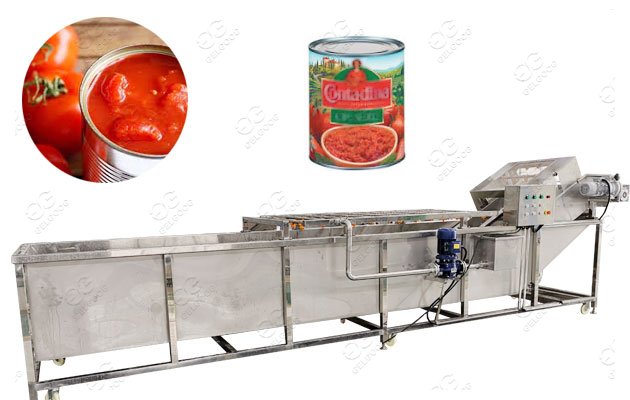What Type Of Machine To Use When Canning Tomato Sauce
 Apr 03 2020
By admin
Apr 03 2020
By admin
If the tomato is processed in the peak season, it can be processed into canned food, which can improves the tomato economic efficiency. Now we introduce tomato canning processing technology with less investment and simple process, which is suitable for small and medium-sized enterprises.The processing process of canned tomatoes is: fruit selection, classification, peeling, bottling, sterilization


Canned tomato processing steps:
First step. Fruit tomato selection:
Choose medium and small fresh or well-refrigerated tomatoes. The fruit surface is required to be smooth and free of pits, bright colors, thick and dense flesh, small cavity, good flavor and full ripeness, but not mature.
Second step, tomato classification:
Pour the selected tomatoes into a tomato washing machine to wash them, and then sorting them according to size. After grading, use a knife to dig out the pedicel, not too deep to avoid the outflow of seeds.
Third step, Tomato peeling:
Pour the tomato into the slightly boiling hot water and blanching tomato for about 1 minute to loosen the skin layer, then quickly put it in cold water to cool, peel off the skin, and trim the surface of the fruit to remove the green or other spots. Then put it in a calcium chloride solution with a concentration of 0.5% and immerse and harden it for about 10 minutes. After taking out, the residual liquid is washed with clean water by tomato washing machine, and then sorted according to quality standards. The lateral diameter of the fruit should be less than 50 mm.
Fourth step, bottling:
After sorting, it is packed in a cleaned and sterilized glass container. In addition, the cooked tomatoes were beaten with a sieve plate hole diameter of 1.5 and 0.5 mm. Beat into the original juice containing 5% -7% of soluble solids. Take 96.5 kilograms of raw juice, add 7 kilograms of 20% brine, 2 kilograms of granulated sugar, and 0.1 kilograms of calcium chloride. After mixing and dissolving, heat up to above 90 ℃, and then put it in a bottle with insufficient acidity. At this time, the pH value can be adjusted below 4.5 with citric acid.
Fifth steps. Sterilization:
Pre-seal (not tightly sealed) after filling the canister, send it to the hot water exhaust box, and heat up to the central temperature of about 75 ℃ in the hot water of 85-90 ℃, immediately seal the canister. Then send it to the sterilization cabinet and sterilize at 105 ℃ for 30 minutes. Note that the heating time should not exceed 10 minutes. For large tanks, the sterilization time should be extended accordingly. After sterilization, use 75 ℃, 55 ℃ and 35 ℃ water in 15 minutes to cool down in stages to below 40 ℃. If the temperature is too low, the tank body may burst. Take it out after cooling, wipe it dry, and after passing the sample inspection, label it for storage or sale.
The characteristic of this can is that it does not remove the fruit core, the tomato is not separated and precipitated, and a small amount of seeds is allowed. The tomatoes can also be peeled and cut open to remove the heart and then canned. In general, the tomato can be cut into thin strips, stuffed into wine bottles, and sealed after sterilization.
If you want to produce canned tomato production business, please feel free to contact us. We can provide a suitable design scheme for the production of canned tomato paste according to your requirements.

